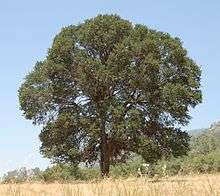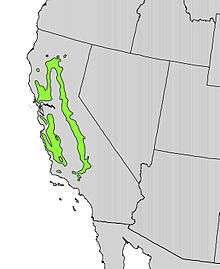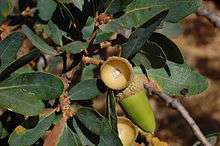Quercus douglasii
| Blue oak | |
|---|---|
 | |
| A large blue oak in a pasture in Mariposa County, California. | |
| Scientific classification | |
| Kingdom: | Plantae |
| Clade: | Angiosperms |
| Clade: | Eudicots |
| Clade: | Rosids |
| Order: | Fagales |
| Family: | Fagaceae |
| Genus: | Quercus |
| Subgenus: | Quercus subg. Quercus |
| Section: | Quercus sect. Quercus |
| Species: | Q. douglasii |
| Binomial name | |
| Quercus douglasii | |
 | |
| Natural range | |
| Synonyms[2] | |
| |
Quercus douglasii, known as blue oak, is a species of oak endemic to (found only in) California, common in the Coast Ranges and foothills of the Sierra Nevada.[3] It is occasionally known as mountain oak and iron oak.[4][5]
Description


Quercus douglasii is a medium-sized tree, generally 6–20 m (20–66 ft) tall, with a trunk 36–60 cm (1–2 ft) in DBH.[6] The tallest recorded specimen was found in Alameda County, at 28.7 m (94 ft). The bark is light gray with many medium-sized dark cracks; from a distance, it can appear almost white. The name blue oak derives from the dark blue-green tint of its leaves, which are deciduous, 4–10 cm (1.6–3.9 in) long, and entire or shallowly lobed. The acorns are 2–3 cm (0.8–1.2 in) long,[7] with a moderately sweet kernel, and mature in 6–7 months from pollination. They are slow growers, growing only 12 inches (30 cm) per year.[8]
Allergenicity
Blue oak pollen is a severe allergen.[9]
Ecology
Quercus douglasii prefers dry soil and plenty of sunlight. It is the most drought tolerant of California's deciduous oaks.[6]
Quercus douglasii often co-habitates with gray pine (Pinus sabiniana), and is also found with interior live oak (Q. wislizeni), valley oak (Q. lobata), Oregon white oak (Q. garryana),[6] canyon live oak (Q. chrysolepis), and Pacific madrone (Arbutus menziesii). Natural hybrids between Q. douglasii and the related shrub live oak (Q. turbinella), Q. lobata, and Q. garryana often occur where the species grow together in the same area.
Individual trees over 500 years old have been recorded, although most are less than 300 years old. Recent research has found several unlogged stands of blue oak woodlands, suggesting that the state may harbor over 500,000 acres (200,000 ha; 2,000 km2) of such old-growth forests.
Quercus douglasii is not susceptible to the fungal disease known as sudden oak death.[10]
See also
| Wikimedia Commons has media related to Quercus douglasii. |
References
- ↑ "Quercus douglasii". iucnredlist.org. iucnredlist. 2016. Retrieved 4 November 2017.
data
- ↑ "Quercus douglasii". World Checklist of Selected Plant Families (WCSP). Royal Botanic Gardens, Kew – via The Plant List.
- ↑ iGoTerra—Blue Oak (Quercus douglasi) Archived May 26, 2013, at the Wayback Machine.
- ↑ McDonald, Philip M. (1990). "Quercus douglasii". In Burns, Russell M.; Honkala, Barbara H. Hardwoods. Silvics of North America. Washington, D.C.: United States Forest Service (USFS), United States Department of Agriculture (USDA). 2 – via Southern Research Station (www.srs.fs.fed.us).
- ↑ "Quercus douglasii". Calflora: Information on California plants for education, research and conservation, with data contributed by public and private institutions and individuals, including the Consortium of California Herbaria. Berkeley, California: The Calflora Database – via www.calflora.org.
- 1 2 3 Fryer, Janet L. (2007). "Quercus douglasii". Fire Effects Information System (FEIS). US Department of Agriculture (USDA), Forest Service (USFS), Rocky Mountain Research Station, Fire Sciences Laboratory – via https://www.feis-crs.org/feis/.
- ↑ Nixon, Kevin C. (1997). "Quercus douglasii". In Flora of North America Editorial Committee. Flora of North America North of Mexico (FNA). 3. New York and Oxford – via eFloras.org, Missouri Botanical Garden, St. Louis, MO & Harvard University Herbaria, Cambridge, MA.
- ↑ "SelecTree: Tree Detail BLUE OAK". calpoly.edu. calpoly. 2018. Retrieved 9 June 2018.
blue oak data
- ↑ http://www.pollenlibrary.com/Local/Specie/Quercus+douglasii/in/Santa%20clara%20County/CA/
- ↑ https://www.aphis.usda.gov/plant_health/plant_pest_info/pram/downloads/pdf_files/usdaprlist.pdf
Further reading
- Stahle, David. "Ancient Blue Oak Woodlands of California". University of Arkansas Tree-Ring Laboratory. Archived from the original on 2008-12-04. Retrieved 2008-11-10.
- Peterson- Raptors of California
